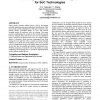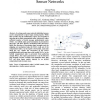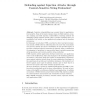46 search results - page 6 / 10 » Preventing Pollution Attacks in Multi-source Network Coding |
ICC
2008
IEEE
14 years 2 months ago
2008
IEEE
Abstract—Under the emerging network coding paradigm, intermediate nodes in the network are allowed not only to store and forward packets but also to process and mix different dat...
CODES
2003
IEEE
14 years 28 days ago
2003
IEEE
Future wireless internet enabled devices will be increasingly powerful supporting many more applications including one of the most crucial, security. Although SoCs offer more resi...
JCM
2008
13 years 7 months ago
2008
In a large-scale sensor network individual sensors can be compromised to inject bogus sensing reports. While SEF can filter out the outfield false reports, it is incapable of detec...
INFOCOM
2007
IEEE
14 years 1 months ago
2007
IEEE
Abstract— Network coding substantially increases network throughput. But since it involves mixing of information inside the network, a single corrupted packet generated by a mali...
RAID
2005
Springer
14 years 1 months ago
2005
Springer
Abstract. Injection vulnerabilities pose a major threat to applicationlevel security. Some of the more common types are SQL injection, crosssite scripting and shell injection vulne...



